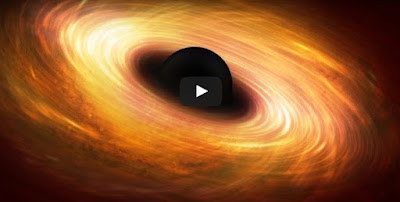Scientists from Moscow organization of Physics and Technology, the organization for Theoretical and Experimental Physics, and the National study University Higher School of Economics have devise a way of distinguishing black holes from compact massive substance that are outwardly indistinguishable from one another. The process involves studying the energy spectrum of particles touching in the vicinity, which can be continuous or separate. The answer have been published in Physical Review D.
Black holes, which were predict by Einstein's theory of universal relativity, have an event horizon – a boundary beyond which nothing, still light, can return to the outside world. The radius of this border is calling the Schwarzschild radius. In physical terms, it is the radius of an thing for which the escape velocity is greater than the speed of light, which income that nothing is clever to overcome its gravity.Black holes of stellar mass are the effect of gravitational collapse that occurs when a star exhaust all its thermonuclear fuel and the power of the gas pressure can no longer oppose gravity. If the star is massive sufficient, it collapses to a size smaller than the Schwarzschild radius & turns into a black hole. However, time on the event horizon slows down so a huge deal that for an outside observer, the collapsing procedure roughly stops (if a ship falls into a black hole, for instance, it will appear to be continually falling on the way to the horizon to an outside observer). Therefore, all black holes are seen as substance that are eternally collapsing.
Astrophysicists have not yet been able to watch a black hole directly, but there are a lot of objects that are suspected black holes. Most scientists consider that in the centre of our galaxy, there is a supermassive black hole; there are dual systems in which one of the components is the majority likely a black hole. However, a quantity of astrophysicists believe that there may be compact massive objects that fall very somewhat short of black hole status; their range is only a little bigger than the Schwarzschild radius. From the exterior, however, they are not discernible from black holes.
Emil Akhmedov, Fedor Popov, and Daniil Kalinov devised a way to distinguish the dissimilarity between compact massive substance and collapsing objects.
"We examined the scalar quantum meadow around a black hole and a compact thing and establish that around the collapsing object—the black hole—there are no bound states, but about the compact object, there are," explains Fedor Popov, a part of staff at MIPT's Laboratory of High Energy Physics.
He and his colleagues examine the behaviour of scalar particles, which have zero spin—an instance could be the Higgs boson—in the environs of black holes and massive compact objects. The scientists derived analytical language for the energy spectrum of the particles. It was establish that near the surface of an ultra-compact star with a radius somewhat larger than the Schwarzschild radius there is a "potential hole"—an region of space where particle fall into a gravitational "trap." The spectrum of the particles in the possible hole is discrete, i.e. it has energy standards where there are no particles. In simpler terms, the possible hole does not release particle at certain energies, and an empty space is observed in the spectrum.
In the container of a black hole in the vicinity of a Schwarzschild sphere, there are no motionless potentials. As there is a steady process of collapse, the boundary of the "hole" moves gone and the energy spectrum is continuous.
"We scatter a beam of particles on the thing and observe the spectrum. And we see that if there are no separate levels in the spectrum, it is a black hole, and if there are, it is a compact thing. Although this particular learn focused on spinless particles, we can assume that the range of other types of particles would behave in the same way," says Fedor Popov.
He notes that so far, this is just a theoretical study; astronomers do not yet have the income to observe the spectra of particles in the vicinity of possible black holes—but currently they are one step closer.

Comments
Post a Comment